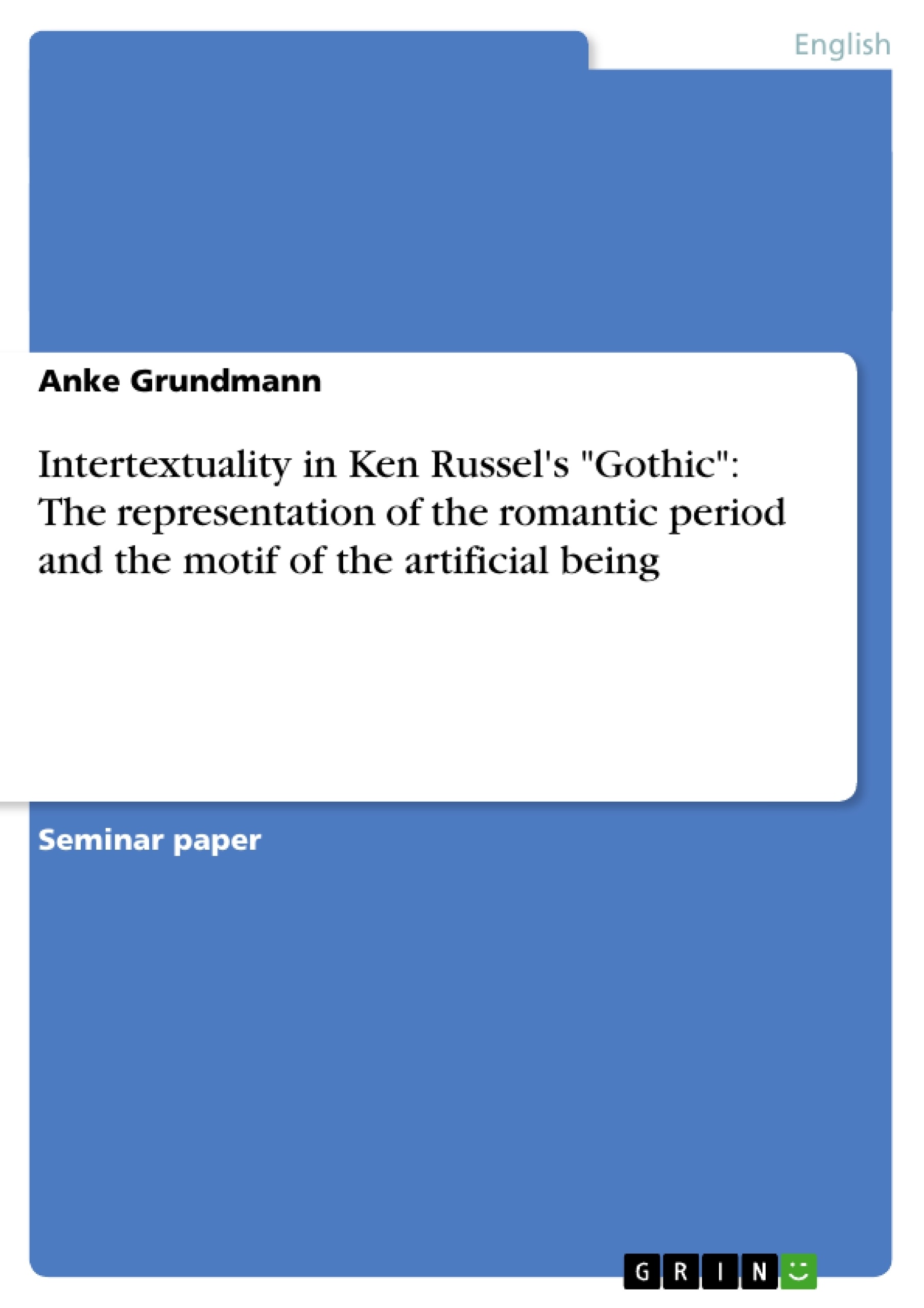The film Gothic starring Gabriel Byrne (in the role of Lord Byron), Julian Sands (Percy Bysshe Shelley), Natasha Richardson (Mary [Wollstonecraft Godwin] Shelley), Myriam Cyr (Claire Clairmont) and Timothy Spall (Dr John Polidori) and directed by Ken Russell was made in 1986.
It is difficult to decide whether the film is a horror film or a period film because it contains elements of both genres. The viewer’s judgement depends on his or her previous knowledge of the life of the characters. If the viewer does not recognize the relation between the elements and statements in the film and texts written by and about the protagonists he or she will feel Gothic to be mainly a horror film. In other words intertextuality plays an important role in Gothic. Therefore, the aim of this term paper is to analyze the intertextual relations between the film and various texts.
Since there are many different concepts concerning intertextuality I will mostly focus on Julia Kristeva’s idea of intertextuality in the first chapter. In the second chapter the literary historical aspects of Gothic will be examined. The film is set in 1816, i.e. in the second phase of the Romantic period. I will analyze how Ken Russell represents some of the characteristics of the Romantic period in his film. Among others, a motif in the film is the artificial being and the creation of an artificial being respectively. This motif is also the topic of Mary Shelley’s novel Frankenstein. The third chapter deals on the one hand with the question how the motif „artificial being“ is represented in Ken Russell’s film and on the other hand in how far this parallels the novel Frankenstein and Gothic. Finally, the aim of the fourth chapter is to compare the “real” events around the group of the Villa Diodati with the fictional image the director gives in Gothic.
Concerning the secondary literature to compare to the film I could have used texts about almost all of the characters included. I decided to concentrate on Lord Byron and Mary Shelley. Byron is the most extravagant figure of the five persons. Besides, the atmosphere is very much dominated by him.
Inhaltsverzeichnis (Table of Contents)
- 0. Introduction
- 1. Concepts of Intertextuality
- 2. The Representation of the Romantic Period in Gothic
- 2.1 Byron and the “Byronic Hero”
- 2.2 Exclusion of Reality
- 2.3 Rejection of Conventions and Morality
- 2.4 The Motifs “Death” and “Night”
- 2.5 The Relation to the “Gothic Novel”
- 3. The Motif of the “Artificial Being”
- 3.1 The Artificial Women
- 3.2 The Being created in the Mind
- 4. Gothic Fact or Fiction?
- 4.1 Ghost-Story Contest and Scientific Discussions
- 4.2 The Role of Claire
- 4.3 Mary Shelley and her “Child” Frankenstein
- 4.4 Real and Fictional Visions
- 4.5 “Visual” Intertextuality
- 5. Summary
- 6. Works Cited
Zielsetzung und Themenschwerpunkte (Objectives and Key Themes)
The aim of this term paper is to analyze the intertextual relations between Ken Russell's film Gothic and various texts. This includes examining how the film represents the Romantic period and the motif of the artificial being, drawing parallels to Mary Shelley's Frankenstein. It also explores how the film compares the real events surrounding the Villa Diodati group with the fictionalized image presented.
- Intertextuality in Ken Russell's Gothic
- Representation of the Romantic Period
- The Motif of the Artificial Being
- Comparison between real and fictional events
- Analysis of the film's intertextual relationships with various texts
Zusammenfassung der Kapitel (Chapter Summaries)
Chapter 1 examines different concepts of intertextuality, focusing on Julia Kristeva's idea of intertextuality as a "mosaic of quotations." This chapter also explores the concept of intertextuality between different media. Chapter 2 analyzes the representation of the Romantic period in Gothic, focusing on elements such as the "Byronic Hero," the exclusion of reality, the rejection of conventions and morality, and the motifs "death" and "night." Chapter 3 delves into the motif of the "artificial being" in the film, comparing it to Mary Shelley's novel Frankenstein and examining how the artificial being is represented in both contexts. Chapter 4 aims to compare the real events surrounding the Villa Diodati group with the fictionalized image presented by the director in Gothic.
Schlüsselwörter (Keywords)
This term paper explores the themes of intertextuality, the Romantic period, Gothic literature, artificial being, and the creation of artificial beings. It analyzes the representation of the Romantic period in Ken Russell's film Gothic, specifically focusing on Lord Byron, Mary Shelley, and the novel Frankenstein. The term paper also investigates the relationship between real events and fictionalized representations of the Villa Diodati group and their interactions.
- Citar trabajo
- M.A. Anke Grundmann (Autor), 1998, Intertextuality in Ken Russel's "Gothic": The representation of the romantic period and the motif of the artificial being, Múnich, GRIN Verlag, https://www.grin.com/document/38792



